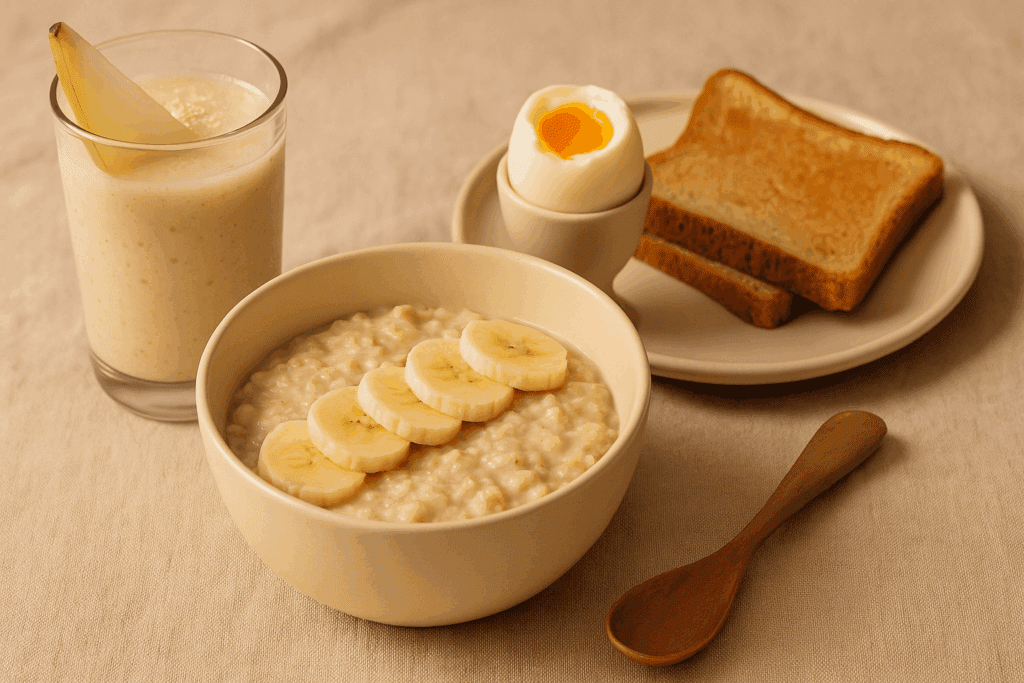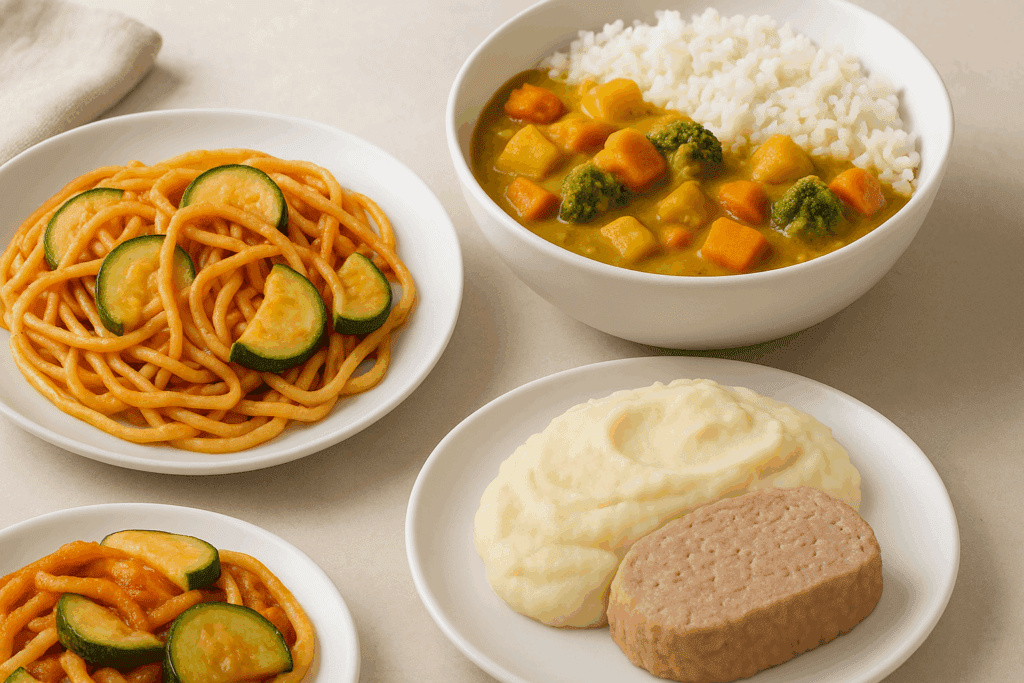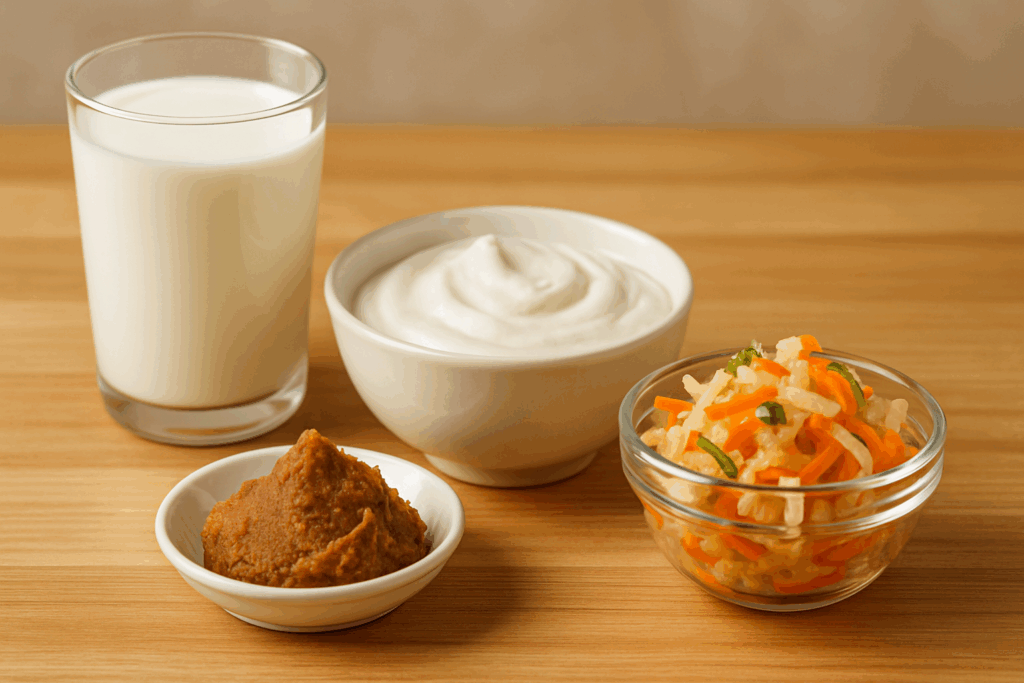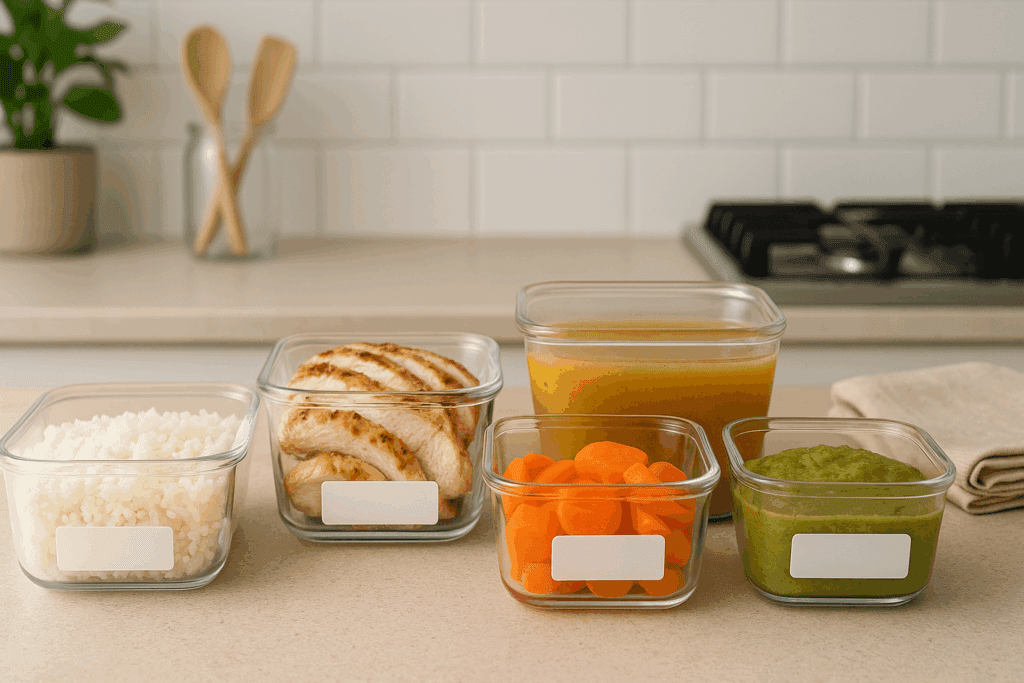For many people navigating the challenges of digestive discomfort, dietary changes can feel overwhelming and restrictive. However, the concept of comfort food need not be at odds with digestive health. In fact, meals that are easy on the stomach can be soothing, satisfying, and full of nourishing ingredients that promote healing. From those managing irritable bowel syndrome (IBS) and acid reflux to those recovering from illness or simply seeking a gentler, more mindful approach to eating, the right recipes can offer both relief and enjoyment. This article explores expert-recommended meals that are easy on the stomach, providing both clinical insight and culinary inspiration for better digestive health.
You may also like: Delicious Meets Nutritious: How to Create Healthy Food with Flavor Using Expert-Backed Diet Recipes and Cooking Tips

Understanding Digestive Sensitivities and Their Triggers
Digestive discomfort often stems from a range of factors, including underlying gastrointestinal conditions, dietary intolerances, medication side effects, stress, and even aging. For example, those with IBS may experience bloating, cramps, and irregular bowel movements triggered by certain carbohydrates known as FODMAPs, while individuals with GERD may find that spicy or acidic foods exacerbate reflux. The importance of identifying and avoiding personal triggers is paramount, and food journals, elimination diets, and professional guidance from registered dietitians or gastroenterologists can be essential tools in this process. Once triggers are understood, the focus shifts from restriction to nourishment—seeking out easy on the stomach recipes that support digestion without compromising taste or nutrition.
Why Easy on the Stomach Recipes Matter for Healing
When the digestive system is inflamed, irritated, or otherwise compromised, it requires rest and support to heal effectively. Meals that are easy on the stomach reduce the workload on the gastrointestinal tract, minimize the risk of triggering symptoms, and help maintain hydration and nutritional balance. For instance, cooked vegetables are often more tolerable than raw ones because the heat breaks down tough fibers, making them easier to digest. Similarly, simple starches like white rice or potatoes can provide energy without irritating the gut. In times of illness or recovery, such meals are not only physically restorative but emotionally comforting as well. The role of food in healing extends beyond nutrients—it offers familiarity, stability, and a sense of care, especially when chosen mindfully.
Principles of Creating Meals That Are Easy on the Stomach
Designing meals that are easy on the stomach involves a delicate balance of simplicity, nutrition, and palatability. Experts recommend avoiding ingredients that are known to cause bloating, gas, or irritation. High-fat, fried, or heavily spiced foods tend to be more taxing on digestion. Instead, meals should prioritize lean proteins, well-cooked vegetables, and easily digestible grains. Cooking techniques such as steaming, poaching, slow simmering, or baking are gentler than frying or charring. It’s also important to incorporate hydrating elements, such as broths and stews, which support digestion and hydration simultaneously. Meals should be eaten slowly and mindfully, in a relaxed setting, to enhance digestive enzyme release and reduce the likelihood of gastrointestinal distress.

Soothing Breakfasts to Start the Day Gently
Mornings offer an opportunity to begin the day with meals that set the tone for digestive wellness. Easy on the stomach recipes for breakfast often include options like oatmeal made with water or lactose-free milk, topped with a ripe banana or a dash of cinnamon. These foods are low in fiber and acidity, making them suitable for sensitive stomachs. Another excellent option is a soft-boiled egg served with toast made from low-FODMAP bread, which provides protein and gentle fiber. Smoothies made with lactose-free yogurt, peeled fruits like pears or mangoes, and a small amount of oats can also offer a well-balanced, easy-to-digest start to the day. The goal is to avoid overwhelming the gut early on while still delivering essential nutrients to fuel the morning.
Midday Meals That Provide Energy Without Upset
Lunch should offer sustained energy without triggering fatigue or bloating. Meals that are easy on the stomach during this time often focus on simplicity and balance. A nourishing option might be a bowl of chicken and rice soup, where the broth is seasoned mildly and the vegetables are soft-cooked. Grilled white fish served with mashed sweet potatoes and steamed zucchini also makes for a gentle yet satisfying meal. For plant-based eaters, a lentil and carrot soup made with well-cooked legumes can offer both protein and fiber in a form that’s easier to process. Pairing meals with calming herbal teas, such as peppermint or chamomile, can further support digestive ease.

Comforting Dinners That Support Digestive Rest
Dinner is the ideal time to embrace calm, grounding meals that prepare the body for rest. Experts suggest focusing on warm, soft foods that are low in acidity and not overly spicy. A classic example is a baked chicken breast served with jasmine rice and steamed carrots, seasoned with a hint of ginger or turmeric, both of which possess anti-inflammatory properties. Another excellent choice is a simple congee or rice porridge, which can be flavored with shredded chicken, scallions, and a touch of sesame oil. The slow-cooked nature of this dish makes it exceptionally easy on the stomach. Vegetarian dinners might include a mild vegetable curry made with coconut milk, featuring ingredients like pumpkin, zucchini, and spinach, served over white rice. The combination of well-cooked vegetables and soothing spices supports not only digestion but also a sense of warmth and comfort.
Snacks and Small Bites That Soothe Rather Than Agitate
Not all eating occurs during main meals. For many individuals, snacks play a vital role in maintaining energy and stabilizing blood sugar levels. Choosing snacks that are easy on the stomach can prevent mid-day discomfort and promote consistent digestive health. Some trusted options include plain rice cakes with almond butter, banana slices, or small servings of Greek yogurt with honey. Soft fruits such as papaya or canned peaches in their own juice are typically well-tolerated. When craving something savory, a handful of unsalted pretzels or homemade broth-based vegetable soup can be satisfying without being harsh. These gentle snacks help sustain energy while avoiding the ingredients that typically cause gastrointestinal distress.

Adapting Cultural Comfort Foods for Digestive Health
Cultural traditions are deeply tied to the meals we find most comforting. However, not all traditional dishes are inherently gentle on the digestive system. Fortunately, with thoughtful adjustments, many beloved meals can be transformed into versions that are easy on the stomach. For instance, Italian pasta dishes can be adapted by using gluten-free or rice-based noodles, limiting cheese, and incorporating soothing ingredients like zucchini or steamed spinach. Mexican cuisine can be modified by choosing corn tortillas, lean proteins, and mild salsas without added onions or garlic. Even classic American comfort foods such as meatloaf or mashed potatoes can be prepared with reduced fat, softened textures, and simpler seasoning. By making these adaptations, individuals can honor their culinary heritage while supporting their health.

The Role of Fermented Foods and Gut Health
While meals that are easy on the stomach are often plain and mild, it’s also important to support the digestive system through the introduction of beneficial bacteria. Fermented foods like kefir, miso, and lactose-free yogurt can play a significant role in promoting gut health, as they contain live cultures that contribute to a balanced microbiome. However, these foods should be introduced slowly, especially in individuals with sensitive stomachs or those not accustomed to probiotics. Incorporating small amounts into easy on the stomach recipes—such as a spoonful of plain yogurt stirred into a smoothie or a teaspoon of miso in a light soup—can deliver the benefits of fermentation without overwhelming the gut. Over time, a stronger microbiome can improve overall digestion and reduce symptoms of gastrointestinal discomfort.
Hydration and Its Overlooked Impact on Digestion
Hydration is a foundational element of digestive wellness, yet it is frequently overlooked when discussing meals that are easy on the stomach. Water plays a key role in softening stool, supporting enzymatic activity, and maintaining the mucosal lining of the intestines. Sipping warm water throughout the day, as well as incorporating hydrating foods like broth-based soups, cucumbers, and melons, can prevent constipation and bloating. Herbal teas, such as fennel or ginger tea, can be particularly helpful for reducing gas and cramping. Avoiding carbonated beverages, alcohol, and excessive caffeine is equally important, as these can irritate the stomach lining and contribute to acid reflux or indigestion. A holistic approach to hydration enhances the efficacy of a stomach-friendly diet.
Mindful Eating Practices That Complement Healing Meals
The way we eat is just as important as what we eat, especially for those with sensitive digestive systems. Mindful eating practices encourage slower, more intentional consumption of food, which allows the body to properly release digestive enzymes and prepare the gastrointestinal system for efficient processing. Chewing food thoroughly, putting down utensils between bites, and avoiding distractions such as television or smartphones can improve satiety and reduce bloating. In addition, listening to hunger and fullness cues helps prevent overeating, which is a common cause of digestive discomfort. Meals that are easy on the stomach are best enjoyed in a calm, unhurried setting that supports the body’s natural rhythm and enhances the healing power of food.
Expert-Recommended Ingredients That Promote Digestive Comfort
While no one ingredient works universally for all individuals, some foods are widely recognized for their gentle effects on digestion. Bananas, for instance, contain pectin and potassium, which support bowel regularity and electrolyte balance. Ginger is well-known for its anti-nausea and anti-inflammatory properties, making it a powerful addition to both sweet and savory recipes. Bone broth, rich in gelatin and amino acids, may support gut lining repair and reduce inflammation. Other easily digestible staples include white rice, steamed carrots, skinless chicken, and low-fat dairy alternatives. These ingredients serve as the foundation for many meals that are easy on the stomach, combining medical wisdom with culinary flexibility.

How to Meal Prep for Digestive Ease
For those managing ongoing digestive issues, planning ahead can make a substantial difference. Meal prepping easy on the stomach recipes ensures that healthy, gentle options are always available, reducing reliance on processed or trigger-laden convenience foods. Cooking large batches of soups, stews, and porridge can provide multiple meals throughout the week, while pre-cutting and steaming vegetables like zucchini or carrots makes them ready for quick reheating. Storing small portions of rice, grilled chicken, or broth in freezer-safe containers supports both convenience and nutritional consistency. Even during busy weeks, these preparations allow individuals to stay aligned with their healing dietary goals without additional stress or decision fatigue.
Navigating Digestive Challenges with Confidence and Compassion
Living with digestive sensitivities often requires a reimagining of one’s relationship with food. Yet, this journey need not be defined by deprivation. Instead, it becomes an opportunity to discover meals that nourish, restore, and delight. With the support of expert guidance, evidence-based nutrition, and personal experimentation, individuals can identify the meals that are easy on the stomach while embracing flavors, traditions, and comfort. Rather than focusing on what must be avoided, the emphasis shifts to what can be included—and how these foods can enhance both physical health and emotional wellbeing.
Frequently Asked Questions (FAQ): Comfort Food That Heals
1. What are some overlooked ingredients that can be used in meals that are easy on the stomach?
While most people focus on rice, bananas, and oatmeal, there are several underrated ingredients that are excellent for meals that are easy on the stomach. Fennel bulb, for instance, has mild anti-inflammatory and carminative properties that support gut motility and reduce bloating. Japanese sweet potatoes are another gentle choice—they are lower in FODMAPs and contain prebiotic fibers that support gut flora without irritating the stomach. Millet is a less-common grain that digests easily and provides a nutty flavor perfect for savory porridges. These lesser-used components can diversify your easy on the stomach recipes without introducing harsh or reactive elements.
2. Can stress impact how well meals that are easy on the stomach are tolerated?
Yes, stress plays a surprisingly powerful role in digestion and can even cause symptoms despite the use of meals that are easy on the stomach. Chronic stress reduces digestive enzyme production, disrupts peristalsis, and can exacerbate conditions like IBS or functional dyspepsia. In such cases, even easy on the stomach recipes may provoke discomfort if meals are eaten in a rushed or anxious state. This is why incorporating relaxation techniques, like diaphragmatic breathing or mindful eating before and during meals, can significantly enhance tolerance and comfort. Pairing nutritional choices with stress reduction strategies is often a missing link in managing sensitive digestion.
3. Are there any long-term benefits to regularly eating meals that are easy on the stomach, even for people without current digestive issues?
Absolutely. Incorporating meals that are easy on the stomach into your weekly rotation can reduce the cumulative burden on your gastrointestinal system and support metabolic efficiency over time. These types of meals often emphasize whole, minimally processed foods that are rich in hydration and anti-inflammatory properties. Regular consumption can help maintain a healthy gut microbiome, reduce post-meal fatigue, and even support immune health by lowering systemic inflammation. Even for individuals with no overt gastrointestinal symptoms, using easy on the stomach recipes as a preventive measure can contribute to overall wellness and digestive longevity.
4. How can athletes or highly active individuals adapt easy on the stomach recipes for their nutritional needs?
Active individuals often need higher protein and caloric intake, which can be challenging when trying to maintain meals that are easy on the stomach. The key is to focus on digestible proteins such as soft-cooked eggs, tender chicken breast, and fermented dairy like kefir, which provide bioavailable nutrients without taxing the digestive tract. Adding calorie-dense but gentle sources like avocado, olive oil, or small portions of white rice can help meet energy needs without introducing excessive fiber or fat. Smoothies can also be customized using gut-friendly ingredients to support post-exercise recovery. With thoughtful planning, easy on the stomach recipes can be tailored to fuel performance without compromising digestion.
5. Can easy on the stomach recipes support recovery after gastrointestinal surgery or illness?
Yes, meals that are easy on the stomach are often foundational in post-operative nutrition plans and recovery from gastrointestinal illnesses. After surgery or during flare-ups of chronic conditions like Crohn’s disease or ulcerative colitis, the digestive system is particularly vulnerable. Soft, bland, and low-fiber foods minimize irritation and allow tissues to heal while still delivering essential nutrients. In such cases, broths, pureed vegetables, and low-lactose protein sources can help maintain strength and hydration. Medical professionals frequently recommend this dietary approach during the reintroduction phase following bowel rest or medical procedures.
6. How can easy on the stomach meals be made more appealing to children or picky eaters?
Children, especially those with sensory sensitivities or food aversions, may initially resist bland or texture-modified meals. However, easy on the stomach recipes can be customized using mild, naturally sweet vegetables like carrots and sweet potatoes, or by using small cookie cutters for fun shapes in soft foods like pancakes or jellied broths. Adding natural color with foods like mashed pumpkin or pureed mango can make dishes more visually appealing. Including them in the meal preparation process can also boost acceptance and interest. With creativity, meals that are easy on the stomach can be as enjoyable as they are nourishing.
7. Are there emerging scientific trends or innovations in creating meals that are easy on the stomach?
Yes, advancements in food science and personalized nutrition are driving innovation in this area. Precision nutrition platforms now offer microbiome testing that can help individuals determine which easy on the stomach recipes are best suited to their unique gut flora. Additionally, enzyme-enhanced cooking techniques are being developed to pre-break down harder-to-digest proteins or carbohydrates in foods. There are also growing applications of low-histamine and anti-inflammatory meal plans within this category, tailored specifically for individuals with complex food sensitivities or autoimmune conditions. These trends highlight how science is expanding the possibilities for making meals that are easy on the stomach more effective and individualized.
8. Can travel or changes in environment affect tolerance of easy on the stomach meals?
Yes, environmental changes, especially when traveling, can impact digestion even if you’re eating meals that are easy on the stomach. Jet lag, altered sleep cycles, unfamiliar water sources, and changes in altitude can disrupt circadian rhythms and gastrointestinal motility. Additionally, limited access to familiar foods may require substitution with packaged or unfamiliar ingredients that, while intended to be easy on the stomach, may trigger unexpected reactions. Preparing travel-friendly easy on the stomach recipes, such as vacuum-sealed broths or instant oatmeal with known tolerable add-ins, can help maintain digestive stability on the go. Travel supplements like probiotics or digestive enzymes can also provide extra support.
9. How can someone transition from a restrictive bland diet to more flavorful easy on the stomach meals without risking flare-ups?
Transitioning from a strictly bland diet to more flavorful meals that are easy on the stomach requires patience and strategic ingredient testing. Introducing new spices such as turmeric, cumin, or fresh herbs in small amounts allows the palate to adjust without overwhelming the gut. Roasting vegetables instead of boiling them can enhance taste while maintaining digestibility. Incorporating bone broths as a base for risottos or soups adds umami depth without relying on acidic or spicy additives. Gradual layering of flavors ensures that easy on the stomach recipes can evolve from basic to delicious while maintaining safety for sensitive systems.
10. What social or psychological benefits come from eating meals that are easy on the stomach?
Beyond the physical advantages, there are emotional and social gains that come from regularly consuming meals that are easy on the stomach. People with chronic digestive issues often experience anxiety or isolation around food-related events, fearing discomfort or embarrassment. Having go-to easy on the stomach recipes empowers individuals to participate confidently in meals with others, fostering inclusion and enjoyment. Psychologically, these meals can also reduce the fear associated with eating, helping to repair strained relationships with food. Over time, this can contribute to greater mental well-being, reinforcing a positive feedback loop between mind, body, and nutrition.
Reflecting on the Healing Power of Easy on the Stomach Meals
Incorporating meals that are easy on the stomach into everyday life is not just a reactive strategy for managing symptoms, but a proactive approach to cultivating digestive resilience and whole-body wellness. These meals, rooted in simplicity and intention, offer more than just temporary relief; they support long-term health by reducing inflammation, enhancing nutrient absorption, and fostering a positive relationship with food. Whether you are recovering from illness, navigating a chronic condition, or simply striving to feel your best, easy on the stomach recipes can become a vital and empowering part of your self-care routine. As we continue to deepen our understanding of the gut-brain connection and the intricate roles of food in healing, one truth remains clear: comfort food, when crafted with care, can truly heal from the inside out.
Further Reading:
52 Easy & Healthy Dinner Ideas Ready in 30 Minutes
15 Best Foods to Eat When You Have an Upset Stomach — Plus, What to Avoid
24 Easy, Gut-Healthy Dinners Ready in 15 Minutes or Less


